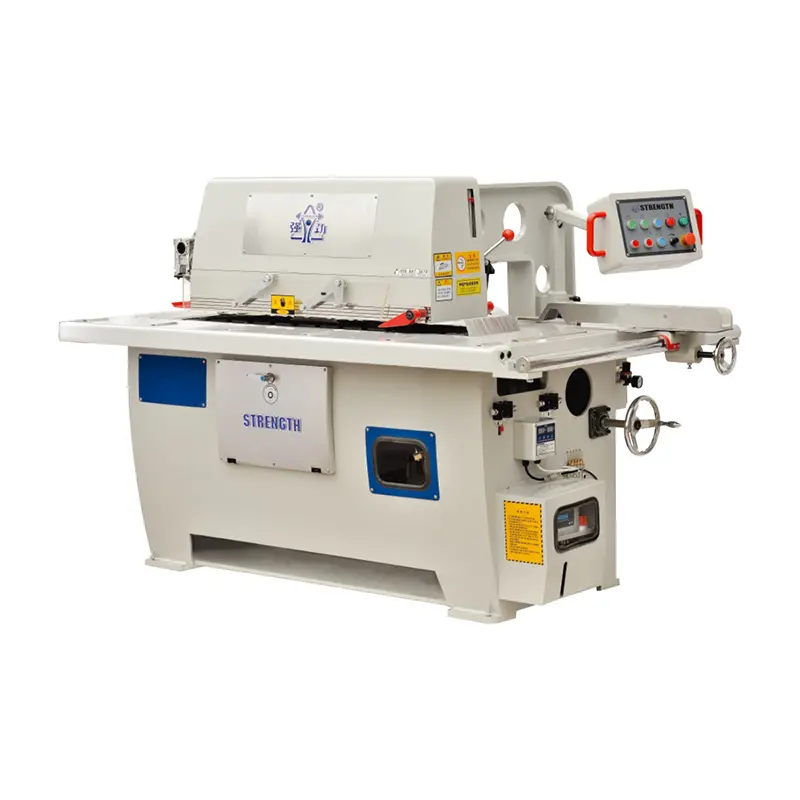For international professional wholesale purchasers and woodworking industry professionals, the automatic single blade saw is a cornerstone of efficient production. Its precision and automation capabilities significantly enhance workflow, but maximizing its potential while ensuring safety requires strict adherence to usage protocols. This blog outlines critical precautions to protect operators, extend equipment lifespan, and maintain consistent cutting quality—key factors for businesses relying on this machinery.
Pre-Operation Safety Checks: Laying the Foundation for Safe Use
Before powering on the automatic single blade saw, a comprehensive pre-operation inspection is non-negotiable. This step not only prevents accidents but also identifies potential issues that could compromise cutting accuracy.
First, verify the stability of the machine base. Ensure all anchor bolts are securely fastened to prevent vibrations during operation, which can lead to uneven cuts and increased wear on internal components. Check that the workbench surface is level; even a slight tilt can affect material positioning and result in dimensionally inaccurate products.
Next, inspect the saw blade itself. Confirm that the blade is compatible with the material being cut—using a blade designed for hardwood on softwood (or vice versa) reduces efficiency and increases the risk of blade damage. Check for signs of wear, such as chipped teeth or warping, and replace the blade immediately if defects are found. Additionally, ensure the blade is properly installed with the correct direction of rotation; a reversed blade can cause kickback, a dangerous scenario where the material is forcefully ejected.
Electrical systems demand careful attention. Examine power cords for fraying or damage, and ensure the machine is connected to a grounded power source to prevent electric shock. Test emergency stop buttons to confirm they function correctly—these should halt all operations instantly when pressed, serving as a critical safety backup.
Finally, clear the work area of debris, tools, or loose materials. Cluttered spaces increase the risk of tripping hazards and can interfere with material feeding, leading to jams or misalignments during cutting.
Operational Protocols: Ensuring Precision and Safety During Use
Once pre-operation checks are complete, strict adherence to operational protocols is essential to maintain safety and cutting quality.
Operator attire is a fundamental safety measure. Loose clothing, jewelry, or long hair can get caught in moving parts, causing serious injury. Operators must wear short sleeves, remove jewelry, and secure long hair under a cap. Additionally, safety glasses are mandatory to protect against flying wood chips, and gloves should be worn when handling rough materials—though gloves must be removed before operating controls to avoid entanglement.
When feeding materials into the saw, always use push sticks or guides for small or narrow pieces. Never use hands to push material within 15 cm of the blade, as this significantly increases the risk of contact with the moving blade. For larger materials, ensure they are properly supported to prevent sagging, which can cause uneven cuts or material slippage.
Maintaining a consistent feed rate is crucial for both cutting quality and equipment health. Feeding material too quickly can overload the motor, cause the blade to bind, or result in rough cuts. Conversely, feeding too slowly can overheat the blade and burn the material. Refer to the machine’s manual for recommended feed rates based on material type and thickness.
Never leave the machine unattended while it is running. If a jam occurs, turn off the power immediately and wait for the blade to stop completely before attempting to clear the jam. Never use hands or tools to clear a jam while the blade is moving, as this can lead to severe injury.
Additional Considerations for Long-Term Safety and Efficiency
Beyond daily operations, several long-term practices contribute to the safe and efficient use of automatic single blade saws.
Regular calibration is essential to maintain cutting accuracy. Over time, components can shift, leading to misalignments between the blade and guides. Follow the manufacturer’s guidelines for calibration frequency, and use precision tools to ensure the blade is parallel to the fence and perpendicular to the workbench.
Training is another critical factor. Ensure all operators are thoroughly trained on the specific model of automatic single blade saw they will be using. Training should cover pre-operation checks, operational protocols, emergency procedures, and basic maintenance. Regular refresher training can help reinforce safe practices and address any new issues that arise.
Keep a maintenance log to track inspections, repairs, and blade replacements. This log helps identify patterns, such as frequent blade wear or recurring issues, allowing for proactive maintenance and reducing the risk of unexpected breakdowns.
Finally, always refer to the manufacturer’s manual for model-specific guidelines. While general precautions apply to most automatic single blade saws, each model may have unique features or requirements that must be followed to ensure safety and performance.
By following these comprehensive precautions, operators can maximize the efficiency, precision, and lifespan of automatic single blade saws while minimizing the risk of accidents. For wholesale purchasers, ensuring that end-users are trained in these practices not only protects their investment but also enhances the reputation of the equipment as a reliable, safe solution for woodworking operations.
Post time: Aug-18-2025

